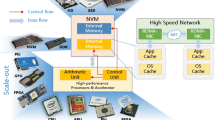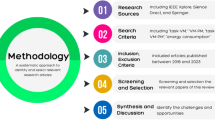Abstract
With the increasing demand and the wide application of high performance commodity multi-core processors, both the quantity and scale of data centers grow dramatically and they bring heavy energy consumption. Researchers and engineers have applied much effort to reducing hardware energy consumption, but software is the true consumer of power and another key in making better use of energy. System software is critical to better energy utilization, because it is not only the manager of hardware but also the bridge and platform between applications and hardware. In this paper, we summarize some trends that can affect the efficiency of data centers. Meanwhile, we investigate the causes of software inefficiency. Based on these studies, major technical challenges and corresponding possible solutions to attain green system software in programmability, scalability, efficiency and software architecture are discussed. Finally, some of our research progress on trusted energy efficient system software is briefly introduced.
Similar content being viewed by others
References
Poess M, Nambiar R O. Energy cost, the key challenge of today’s data centers: a power consumption analysis of TPC-C results. Proceedings of the VLDB Endowment, 2008, 1(2): 1229–1240
Wirth N. A plea for lean software. Computer, 1995, 28(2): 64–68
Owens J D, Luebke D, Govindaraju N, Harris M, Krüger J, Lefohn A E, Purcell T J. A survey of general-purpose computation on graphics hardware. In: Proceedings of 2005 Annual Conference of the European Association for Computer Graphics. 2005, 21–51
Foster I, Zhao Y, Raicu I, Lu S. Cloud computing and grid computing 360-degree compared. In: Proceedings of 2008 Grid Computing Environments Workshop. 2008, 1–10
Kogge P, Bergman K, Borkar S, Campbell D, Carlson W, Dally W, Denneau M, Franzon P, Harrod W, Hill K, Hiller J, Karp S, Keckler S, Klein D, Lucas R, Richards M, Scarpelli A, Scot S, Snavely A, Sterling T, Williams R S, Yelick K. Exascale computing study: technology challenges in achieving exascale systems. DARPA Report. 2008
Moore G E. Progress in digital integrated electronics. In: Proceedings of IEEE Digital Integrated Electronic Device Meeting. 1975, 11–13
Kish L B. End of Moore’s law: thermal (noise) death of integration in micro and nano electronics. Physics Letters A, 2002, 305(3–4): 144–149
Lloyd S. Ultimate physical limits to computation. Nature, 2000, 406(6799): 1047–1054
Manferdelli J. Supercomputing and mass market desktops. ACM Super Computing, 2007
Seiler L, Carmean D, Sprangle E, Forsyth T, Abrash M, Dubey P, Junkins S, Lake A, Suqerman J, Cavin R, Espasa R, Grochowski E, Juan T, Hanrahan P. Larrabee: a many-core x86 architecture for visual computing. ACM Transactions on Graphics, 2008, 27(3): 1–15
Geer D. Chip makers turn to multicore processors. Computer, 2005, 38(5): 11–13
Environmental Protection Agency. EPA report to Congress on server and data center energy efficiency. 2007, http://www.energystar.gov/ia/partners/prod_development/downloads/EPA_-Datacenter_Report_Congress_Final1.pdf
Brown D J, Reams C. Toward energy-efficient computing. Communications of the ACM, 2010, 53(3): 50–58
Kant K. Data center evolution: a tutorial on state of the art, issues, and challenges. Computer Networks, 2009, 53(17): 2939–2965
Dally WJ, Balfour J, Black-Shaffer D, Chen J, Harting R C, Parikh V, Park J, Sheffield D. Efficient embedded computing. Computer, 2008, 41(7): 27–32
Chu S. The energy problem and Lawrence Berkeley National Laboratory. Talk given to the California Air Resources Board. 2008
Brown D, Furber S. A conversation with Steve Furber. ACM Queue: Tomorrow’s Computing Today, 2010, 8(2): 1–8
Saxe E. Power-efficient software. Communications of the ACM, 2010, 53(2): 44–48
Chamberlain B L, Callahan D, Zima H P. Parallel programmability and the Chapel language. International Journal of High Performance Computing Applications, 2007, 21(3): 291–312
Dean J, Ghemawat S. MapReduce: simplified data processing on large clusters. Communications of the ACM, 2008, 51(1): 107–113
Fatahalian K, Horn D R, Knight T J, Leem L, Houston M, Park J Y, Erez M, Ren M, Aiken A, Dally W J, Hanrahan P. Sequoia: programming the memory hierarchy. In: Proceedings of ACM/IEEE Conference on Supercomputing. 2006
Hoisie A, Getov V. Extreme-scale computing-where ‘just more of the same’ does not work. Computer, 2009, 42(11): 24–26
Torrellas J. Architectures for extreme-scale computing. Computer, 2009, 42(11): 28–35
Barker K J, Davis K, Hoisie A, Kerbyson D J, Lang M, Pakin S, Sancho J C. Using performance modeling to design large-scale systems. Computer, 2009, 42(11): 42–49
Chase J S, Anderson D C, Thakar P N, Vahdat A M, Doyle R P. Managing energy and server resources in hosting centers. In: Proceedings of 18th ACM Symposium on Operating Systems Principles. 2001, 103–116
Zeng H, Ellis C S, Lebeck A R, Vahdat A. ECOSystem: managing energy as a first class operating system resource. In: Proceedings of 10th International Conference on Architectural Support for Programming Languages and Operating Systems. 2002, 123–132
Song Y, Zhang Y W, Sun Y Z, Shi W S. Utility analysis for internet-oriented server consolidation in VM-based data centers. In: Proceedings of 2009 IEEE International Conference on Cluster Computing. 2009, 1–10
Padala P, Hou K Y, Shin K G, Zhu X, Uysal M, Wang Z, Singhal S, Merchant A. Automated control of multiple virtualized resources. In: Proceedings of 4th ACM European conference on Computer systems. 2009, 13–26
Elnozahy M, Kistler M, Rajamony R. Energy conservation policies for web servers. In: Proceedings of the 4th USENIX Symposium on Internet Technologies and Systems. 2003, 99–112
Song Y, Wang H, Li Y Q, Feng B Q, Sun Y Z. Multi-tiered ondemand resource scheduling for VM-based data center. In: Proceedings of 9th IEEE/ACM International Symposium on Cluster Computing and the Grid. 2009, 148–155
Song Y, Li Y Q, Wang H, Zhang Y F, Feng B Q, Zang H Y, Sun Y Z. A service-oriented priority-based resource scheduling scheme for virtualized utility computing. In: Proceedings of 15th International Conference on High Performance Computing. 2008, 220–231
Padala P, Shin K, Zhu X, Uysal M, Wang Z, Singhal S, Merchant A, Salem K. Adaptive control of virtualized resources in utility computing environments. In: Proceedings of 2nd ACM European Conference on Computer Systems. 2007, 289–302
Sun Y Z, Fang H F, Song Y, Du L, Zhang K, Zang H Y, Li Y Q, Yang Y J, Ao R, Huang Y B, Gao Y W. TRainbow: a new trusted virtual machine based platform. Frontiers of Computer Science in China, 2010, 4(1): 47–64
Author information
Authors and Affiliations
Corresponding author
Additional information
Dr. Yuzhong Sun, a full professor at Institute of Computing Technology, Chinese Academy of Sciences with major research interests focusing on green system software and green computing. He is the member of “Hundred Talented Individuals Project” of Chinese Academy of Sciences.
Dr. Yiqiang Zhao is now a postdoctoral at Institute of Computing Technology, Chinese Academy of Sciences. His major research interests include operating system, virtualization, natural language understanding and green system software design.
Dr. Ying Song is an assistant professor in Institute of Computing Technology, Chinese Academy of Sciences. She mainly interests in computer architecture, parallel and distributed computing, operating system and virtualization technology. her work covers topics such as performance modeling, capacity flowing, green model.
Yajun Yang is a PhD candidate at Institute of Computing Technology, Chinese Academy of Sciences. His major research interests focus on OS, virtualization and distributed storage.
Haifeng Fang is a PhD candidate at Institute of Computing Technology, Chinese Academy of Sciences with major research interests focusing on operating system, virtualization and trusted computing. He is a member of Chinese Computer Federation.
Hongyong Zang received his PhD from Institute of Computing Technology, Chinese Academy of Sciences in 2011. His research interests cover operating system, virtualization and network optimization.
Yaqiong Li received his PhD from Chinese Academy of Sciences in 2011. His major research interests focus on operating system, virtualization and trust computing.
Yunwei Gao is an engineer in Institute of Computing Technology, Chinese Academy of Sciences, with major research interests focusing on operating system, virtualization and distributed system.
Rights and permissions
About this article
Cite this article
Sun, Y., Zhao, Y., Song, Y. et al. Green challenges to system software in data centers. Front. Comput. Sci. China 5, 353–368 (2011). https://doi.org/10.1007/s11704-011-0369-3
Received:
Accepted:
Published:
Issue Date:
DOI: https://doi.org/10.1007/s11704-011-0369-3




